Many of these images came from the Oriental Institute at the University of Chicago.
Due to the number of images on this page, it takes
a while to load.
Why not take a break and grab a cup of coffee and
a fresh danish. You might be here for a few.
Iran
![]()
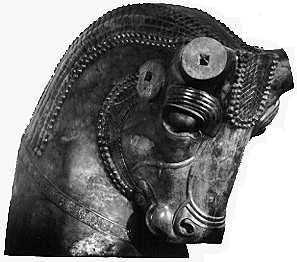 |
Iran: Persepolis, Hundred-Column Hall
Achaemenid Period Reigns of Xerxes/Artaxerxes I, ca. 485-424 B.C. Dark gray limestone; restored 216.0 cm H, 158.0 cm W Carved in the court style typical of the Achaemenid
Empire, this highly polished stone head originally belonged to one of two
guardian bulls flanking the portico of the hundred-columned Throne Hall
at Persepolis. The heads of the bulls projected in the round and the bodies
were carved in relief on the sidewalls of the porch; the ears and horns
had been added separately. The use of pairs of guardian figures such as
these to protect important buildings was a common architectural feature
in the ancient Near East.
|
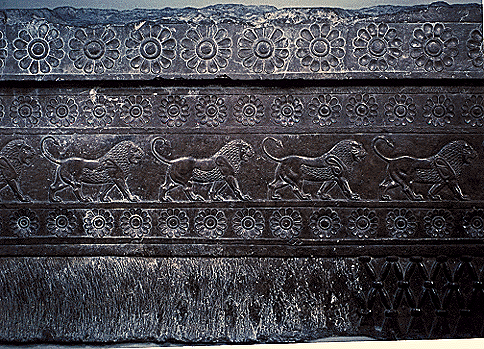 |
Iran: Persepolis
Achaemenid Period Reign of Darius I/Xerxes, ca. 522-465 B.C. Limestone 73.0 cm H, 171.0 cm W An Achaemenid artisan carved this piece of stone to
represent part of a cloth canopy that was decorated with woven or appliquéd
figures of rosettes and striding lions. Remnants of crenellations on the
top of the block indicate that it belonged to the uppermost row of stones.
The fringe along the lower edge, representing knotted cords ending in tassels,
was partly chipped away in ancient times, perhaps before the stone was
reused in the balustrade of a small stairway east of Darius' residential
palace.
|
 |
Iran: Persepolis, Garrison quarters
Achaemenid Period Reign of Xerxes, ca. 485-465 B.C. Gray limestone, inscribed 51.3 cm H, 53.7 cm W This stone tablet inscribed with Babylonian cuneiform characters lists the nations under Persian rule shortly after the uprisings that occurred when Xerxes came to the throne. Although the tablet was intended as a foundation deposit to be placed beneath a corner of one of Xerxes' buildings, it apparently was never used. It was found, along with other tablets bearing the same text in Old Persian and Elamite, employed as the facing of a mud brick bench in the garrison quarters at Persepolis. |
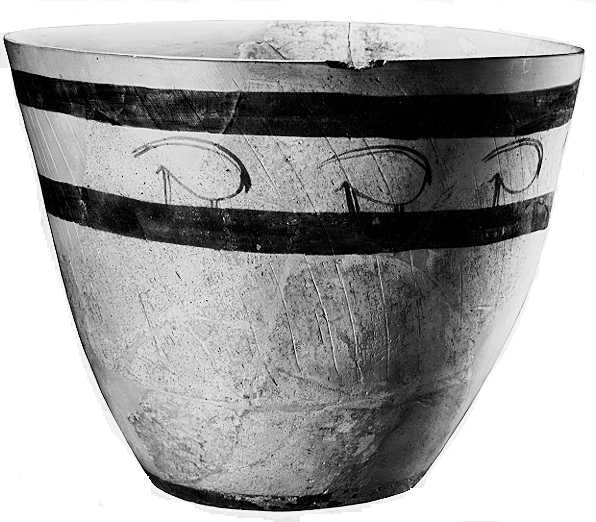 |
Iran: Chogha Mish
Middle Susiana 3 Late 5th millennium B.C. Baked clay 35.0 cm H, 44.0 cm W The geographical term "Susiana," referring to the area
ruled in the historical period by the city of Susa, is also applied to
the prehistoric cultures of lowland southwestern Iran. Representational
designs such as the stylized wild goats with long sweeping horns painted
beneath the rim of this krater are characteristic for an advanced stage
of the Susiana sequence.
|
 |
Iran: Tall-i-Bakun A, Level III
Bakun A Period Early 4th millennium B.C. Baked clay 21.6 cm H, 30.0 cm W Many of the pottery vessels from the site of Tall-i-Bakun in the plain of Persepolis show a highly sophisticated use of negative designs in conjunction with more usual painted patterns. On this bowl, two patterns alternate in rhythmic sequence. One is a painted design of anthropomorphic inspiration with a "head" flanked by upraised "arms" facing both the rim and base of the bowl. The other pattern, which is given in negative by the buff surface of the vessel, consists of a cross and two lozenges. |
 |
Iran: Surkh Dum-i-Luri, Sanctuary, Level 2B
Early Iron Age III, ca. 750-700 B.C. Copper 26.7 cm H, 10.5 cm W Large numbers of decorated disc-headed pins were found in the sanctuary at Surkh Dum-i-Luri. They may have been votive offerings to a fertility goddess or, on analogy with a modern ethnographic parallel, deposits verifying wedding contracts among nomadic peoples moving through the area. The decoration of this example, with an eight-petaled central rosette and surrounding borders of smaller rosettes and punctate patterns, is typical. The tiny incised lion's (?) head faces away from the shaft because the pins were worn with the head hanging down and the shaft pointing up. |
 |
Iranian Plateau
Iron Age, Late 2nd-early 1st millennium B.C. Baked clay, burnished 22.5 cm H, 34.4 cm W Around 1200 B.C. monochrome wares were introduced in
many parts of Iran and replaced the earlier painted pottery. These new,
frequently burnished, wares occur in both a reddish-orange and a dark gray
variety. The gray wares, of which this long-spouted pitcher is a characteristic
example, were given their color by special firing in an oxygen-reducing
atmosphere. They appear to have been ceramic imitations of metal vessels.
|
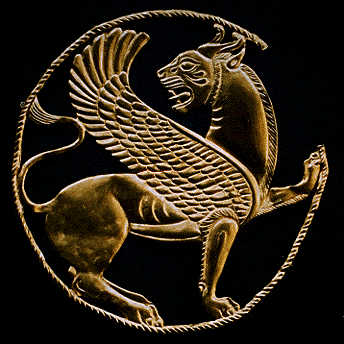 |
Iran: Ecbatana (?)
Achaemenid Period Reign of Artaxerxes II, ca. 404-359 B.C. Gold 11.5 cm H This snarling winged lion worked in gold repoussé
attests to the exceptional skill of Achaemenid goldsmiths. The back of
the horned feline's body and the slender twisted cord that surrounds it
bear sixteen tiny loops for attachment to a garment or textile. Greek writers
often speak of the tremendous wealth of the Persians, and Herodotus writes
that King Xerxes' troops "were adorned with the greatest magnificence...they
glittered all over with gold, vast quantitites of which they wore about
their persons."
|
Palestine
![]()
 |
Palestine: Megiddo, Stratum VII or VI
Late Bronze Age II, ca. 1350-1200 B.C. Gilded bronze 25.4 cm H This statuette of a god may have been the cult figure
in the Canaanite temple in the ruins of which it was found. Cast in bronze
and covered with gold leaf, it is an idol of the type forbidden by the
much later Hebrew prophets. The identity of this bearded and enthroned
deity is uncertain but is most likely to be El-the chief god of the pantheon
and father of the other gods.
|
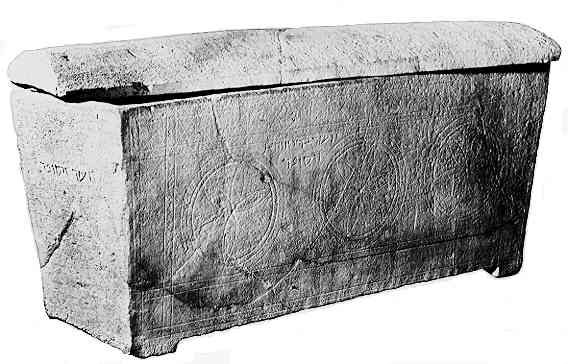 |
Jordan: Jifna
ca. 70 B.C.- 70 A.D. Limestone 33.0 cm H, 67.0 cm W The name "Yo-ezer the scribe" is inscribed on one end
of this ossuary, a repository for bones. Around the end of the 1st century
B.C., Jewish burial practices changed from primary burial in wooden coffins
to secondary burial in small limestone caskets such as this one. The body
seems first to have been buried in a pit until only the bones remained.
These were then gathered up and transferred to the ossuary, which was placed
in a rock-hewn communal tomb.
|
 |
Palestine: Megiddo, Stratum VA-IVB
Iron Age IIA, 10th century B.C. Limestone 67.5 cm H, 29.5 cm W Horned altars are described in the Bible and have been discovered at many Iron Age Israelite sites. This example is probably too small to have been used for animal sacrifice, but may have served for the other three types of offerings known to have been made: wine, incense, and grain meal mixed with oil. The Megiddo stratum in which this altar was found was characterized by large public structures and is generally thought to have been built by King Solomon. It included a four-entryway gate and a well-built double or "casemate" wall. |
 |
Palestine: Megiddo, Stratum VIIA
Late Bronze Age II, 13th century B.C. Ivory inlaid with gold and blue paste 26.5 cm H, 17.8 cm W Two types of gaming boards are found among the Megiddo ivories- one for the "game of 58 holes" and the other for the "game of 20 squares." This is one of four similarly-shaped gaming boards for the "game of 58 holes." Every fifth hole, as well as the central panel, was once inlaid with gold and blue paste. "Studs" of gold leaf found alongside the board may have capped the pegs used to play the game. |
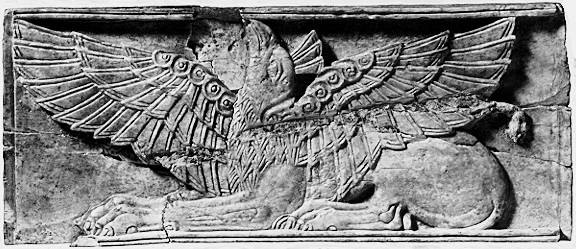 |
Palestine: Megiddo, Stratum VIIA Late Bronze Age II
13th century B.C. Ivory 3.9 cm H, 9.1 cm W This plaque is one of a group of ivories discovered at Megiddo in a semi-subterranean chamber that archaeologists called the "treasury," within a large building that may have been a palace. It bears the figure of a reclining griffin-a composite creature with a lion's body and a bird's head and wings. This motif is borrowed from the art of the Mycenaeans, but it is uncertain whether the object itself was made by a Mycenaean craftsman settled in Asia, by a local ivory carver imitating Mycenaean prototypes, or was imported directly from Greece. |
 |
Palestine: Megiddo, Stratum III
Iron Age IIC, 8th century B.C. Baked clay 4.5 cm H, 13.5 cm W Lamps such as this one consist of a bowl to hold fuel, which was usually olive oil, and a spout to support a wick, which was probably made of flax. The burning wick blackened the spout and must have produced a rather smoky light. The shape of these lamps changed over time, going from an open bowl with four pinched spouts to the one-spouted type shown here and, finally, to a closed lamp with a single spout. These differences in shape are one type of evidence used by archaeologists to date the levels they are excavating. |
 |
Palestine: Megiddo, Stratum VIIA
Late Bronze Age II, 13th century B.C. Ivory These delicate heads belong to a group of ivories discovered at the site of Megiddo, in Palestine. They had been stored in a semi- subterranean chamber that archaeologists called "the treasury," within a large building that may have been a palace. Pairs of heads such as these were attached to cosmetic boxes. A dowel inserted behind one head functioned as the hinge for a flat lid; a dowel behind the other served to fasten the lid closed. The heads show traces of Egyptian influence in their heavily curling locks of hair, which are characteristic of the Egyptian goddess Hathor. |
 |
![]()
|
|